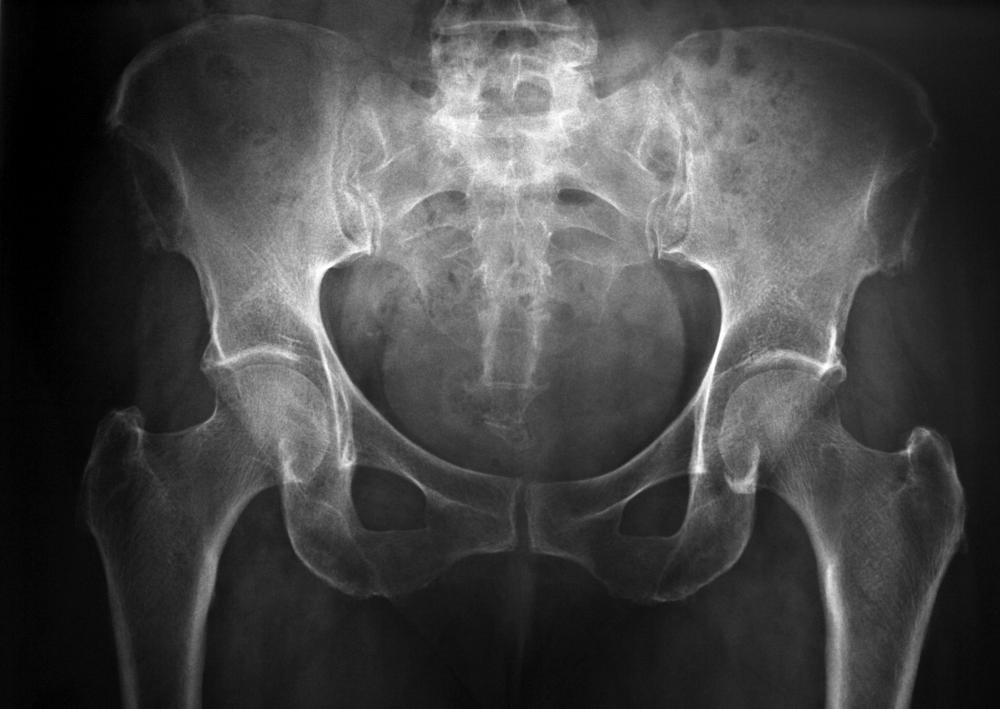At TheHealthBoard, we're committed to delivering accurate, trustworthy information. Our expert-authored content is rigorously fact-checked and sourced from credible authorities. Discover how we uphold the highest standards in providing you with reliable knowledge.
What is Sacroiliac Arthritis?
Sacroiliac arthritis is a condition that results in inflammation and swelling in one or both sacroiliac joints. The joints are located in the middle of the pelvis, and normally help to provide hip stability and shock absorption for the spine. This type of arthritis is often very painful and can be debilitating, making it impossible for a person to stand, walk, or sit for any amount of time without serious discomfort. Arthritis cannot be cured, but doctors can prescribe medications and suggest physical therapy exercises to help manage the condition. Surgery is considered a final effort if other treatment options do not provide relief.
There are several forms of sacroiliac arthritis, and in most cases, pain is not limited to the sacroiliac joints. It is common for person with this type of arthritis to experience stiffness or discomfort in the knees, shoulders, fingers, or neck as well. Osteoarthritis, the gradual degeneration of bone and cartilage tissue, is the primary cause of sacroiliac pain in older people and obese individuals. Rheumatoid arthritis, is an autoimmune disorder that causes joint swelling and may afflict people of all ages.

When the sacroiliac joints are inflamed, it is very uncomfortable to walk, turn, or bend. The lower back often feels tender to the touch, and a person may actually be able to feel bones in the joint scraping against one another. In severe cases, pain tends to radiate throughout the back and legs. Frequent fevers and feelings of nausea are common with progressive cases of arthritis.

A doctor can check for signs of sacroiliac arthritis by conducting a physical exam, taking x-rays of the joints, and collecting a blood sample. Diagnostic imaging tests can reveal the severity and exact location of bone and cartilage degeneration in the case of osteoarthritis. Blood tests are useful in confirming the presence of rheumatoid arthritis. Once a physician has determined the type of arthritis involved, he or she can explain treatment options.

Most cases of sacroiliac arthritis can be managed with oral medications. Painkillers and anti-inflammatory drugs are usually effective in relieving acute symptoms. Topical analgesics may be suggested to ease lower back tenderness. Doctors commonly refer patients to physical therapists to help them maintain joint strength and stay mobile despite their conditions.

Surgery is rarely used in the treatment of sacroiliac arthritis. When a surgical procedure is necessary, a specialist can make an incision in the lower back, suction excess fluid from the joint, and permanently fuse bones together to prevent rubbing and further degeneration. Most patients are confined to beds for several weeks or months following surgery, and typically need extensive physical therapy to regain enough strength to sit and stand unassisted.
AS FEATURED ON:
AS FEATURED ON:

















Discussion Comments
One of the members on our team tennis traveling team was born with one leg shorter than the other. This has not slowed him down at all in terms of his activity level. He says his legs were always the way they are so he never had a reason to complain or think that he should be any different from his friends who were playing sports. By the way, he is one of the top players in his age group.
Unfortunately, the combination of playing tennis, which is tough on the back, and the different lengths of his legs caused a great deal of stress on his sacroiliac joint and ligaments. He is now experiencing pain that might be related to sacroiliac arthritis.
Arthritis of any kind is very painful, or at least it can be. If you live to be old and do not have one of the many arthritis types then you should consider yourself blessed. My mother had gout in her foot.
There were days, weeks and months when she would go through life with no pain or symptoms at all. Then she would have an attack and she would be in so much pain that she couldn't move. The gout mostly affected her foot, so walking was out of the question. She would take pain pills, but she still had pain and swelling.
In the first paragraph of this article there is a sentence that says arthritis cannot be cured. That's what makes the condition so scary to me. Seems like when I was younger, every condition and illness I got could be cured in a few days or a couple weeks at the most. Now, instead of giving me a cure, my doctor tells me I'll have to learn to live with the condition.
Post your comments